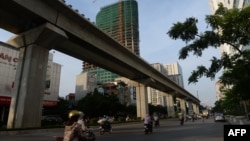Vietnamese business people may be bracing as China, their country's biggest trading partner, devalues its currency and struggles with economic slowdown. Yet Vietnam is making bigger changes that could help turn it into a regional factory export powerhouse.
When China let its yuan currency weaken by 3.5 percent in August, Vietnam took immediate notice. The $186-billion Southeast Asian economy, like China’s, is led by export manufacturing, and that sector grew nearly 9 percent last year. China’s cheaper currency would let Chinese export manufacturers earn more money offshore, competing with their peers in Vietnam.
Vietnam may also face a flood of Chinese imports as its neighbor to the north leans more on other countries to escape slowing demand at home. Pham Luu Hung, associate investment advisory director with SSI Research in Hanoi, said low tariffs and problems in China are already increasing shipments of Chinese trucks and steel to Vietnam.
“We share a border with China, so we import a lot from China, so if the economy is slowing down, I think cheap Chinese products would be easier to come in to flood the market here,” said Hung.
But Vietnam is taking steps to bolster its own exporters. The country of 89 million people and a $50-billion annual trade relationship with China devalued its own currency in August. The central bank in Hanoi had already let the Vietnamese dong weaken twice earlier in the year to stoke more foreign investment in country, not offshore.
Vietnam now vies with its neighbors Cambodia and Myanmar to win factories that produce garments for world export. The Philippines has stepped up construction of infrastructure this year and advertises its English-literate workforce as an incentive for foreign companies to set up plants.
Like much of developing Southeast Asia, Vietnam has also struggled to find money for infrastructure that meets demands of international cargo shippers. It accepted development aid from Japan to open a new air terminal in Hanoi this year and ease overcapacity there. More aid went to help build Ho Chi Minh City’s yet-to-open metro system.
With stronger infrastructure and labor still relatively cheap, Vietnam also hopes to win higher-value manufacturing to replace garments. That ambition competes directly with China's export manufacturing sector. Intel and Samsung Electronics have already invested billions of dollars in Vietnam since 2010, the possible start of a high-tech hardware industry.
The World Bank’s lead Vietnam economist Sandeep Mahajan suggests Vietnam is making few strategic errors.
“Overall the view is that Vietnam is among the more competitive destinations for FDI in the region. So the question is how do they leverage that to the maximum extent? In some sense continuation of the whole model where you have strong growth, that’s the main focus,” said Mahajan.
Mahajan said the Vietnamese private sector needs more access to land and finance so local companies can join the factory supply chain. They might make, for example, tires, headlights for automotive manufacturing.
Today investors from elsewhere in Asia run most of the plants and China sells parts and supplies. A boom in private business would also create wealth in a country where 12 percent live below the official poverty line.
Fabian Knopf, a senior associate with the Hanoi office of international business advisory Dezan Shira & Associates, said Vietnam’s infrastructure now leads other developing Southeast Asian countries. He also points to a 2 percentage-point cut next year in Vietnam’s corporate income tax as another incentive for investment.
“If you compare that in Cambodia and Laos they do have lower wages for manufacturing workers, they can’t provide these packaged services, if you like, on the same level as Vietnam,” said Knopf.
Vietnam is also expected to finish a free-trade agreement with the European Union by 2018 and join the U.S.-led Trans Pacific Partnership trading bloc that’s on track to cover nearly a third of the world economy. Both would cut tariffs in Vietnam’s major export markets but exclude competitors such as China and most other countries in Southeast Asia.






